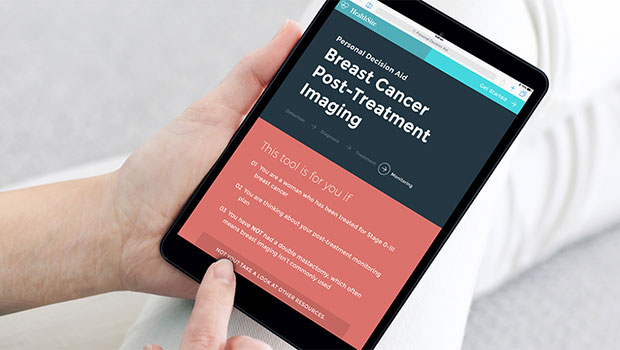Breast cancer screening choice made easier by research-design team

A KPWHRI team finds an ideal partner to create a decision aid for women after breast cancer. Members of a human-centered design group tell their side of the experience.
Women getting breast cancer therapy make a lot of health care decisions. When treatment is over, they confront another: how to get checked for cancer recurrence. The traditional method is mammography but a newer option is breast MRI. Many factors go into choosing one method over the other, including accuracy in detecting second breast cancers, discomfort, and cost.
Women and their physicians now have a decision aid to help them navigate these and other considerations to arrive at a preferred option.
The decision aid was a collaboration between Seattle design group Artefact and the Surveillance Imaging Modalities for Breast Cancer Assessment (SIMBA) project. Funded by the Patient-Centered Outcomes Research Institute and led by Kaiser Permanente Washington Health Research Institute (KPWHRI) Associate Investigator Karen Wernli, PhD, SIMBA studied breast imaging for women who have had breast cancer.
Artefact’s Hannah Staton, marketing and communications manager, and Dave McColgin, designer, talked in person and by email with Chris Tachibana from KPWHRI.
Chris: What made Artefact decide to add SIMBA to your portfolio of work?
Hannah: We find something that matters to us and is a big, daunting issue — what we call a wicked problem — that we can contribute design thinking to solve. All Artefact projects have human-centered design as the guiding principle. Our projects start with a deep understanding of the people involved — what are their priorities? What matters most to them? — and we use those human insights to guide the design. SIMBA was an excellent fit for this philosophy.
Dave: As with all our projects, we started with a combination of learning from expert sources and directly from the affected people, in this case patients experiencing breast cancer. The goal was to develop a deep understanding of what it is like to make health care decisions as a breast cancer patient so we could create a useful and impactful tool for patients and practitioners.
We worked with our wonderful KPWHRI partners, Karen Wernli and Susan Brandzel, to get immersed in their wealth of knowledge on the disease and imaging technologies. We met with Kaiser Permanente clinicians and patients, and supplemented that with additional research with women, patients and practitioners. We reviewed research on what makes decision aids most reliable and effective, what techniques can overcome an initial bias toward one option or the other, and what presentation styles led to more accurate risk perception.
We used this research to inform several design options. Once we had early designs for SIMBA, we involved patients and clinicians again to get feedback and make revisions. Finally, we built a prototype of SIMBA and recruited breast cancer patients to test its usability and effectiveness.
Chris: What was the design experience like, working on SIMBA?
Dave: One of the great things about the SIMBA project was that Karen and Susan were already incorporating human-centered design principles in their work before Artefact came on board. The SIMBA project had a great basis in their existing work, which prioritized long-term involvement, cultivated personal relationships, included focus groups and interviews, and incorporated feedback at multiple stages of their effort. This really helped accelerate the progress and impact of SIMBA, not to mention that Karen and Susan’s knowledge and experience made working on the project a very meaningful partnership. They were right there with us when we geeked out about things like the right statistical approach to our analyses or the simplest ways to explain Type I and Type II errors — false positives and false negatives — to our users. Karen and Susan were exceptional collaborators thanks to their deep expertise!
Coincidentally, the very next project I worked on after SIMBA was to understand the entire breast cancer experience in another country. Our team once again met with patients and clinicians to understand the process, decisions, cultural factors, and opportunities to make women’s lives better. The work with SIMBA was an important reference — it helped us make hypotheses about what we would learn and plan for better about sensitive topics.
Chris: What did you learn from this project?
Dave: Women’s personal experiences of breast cancer had the most to teach me. I learned about the disease as women told me their stories, where facts and diagnoses exist in the context of physical symptoms of cancer and treatment, the frustration of multiple sources and opinions, logistical challenges of shuffling between different places and appointment types, and the huge shift in priorities as life is rearranged. While the survival rate is relatively high, every life is changed and women go through a dizzying ordeal. I was most impressed with patients’ commitment to health and their vigilance that lasted even decades after their treatment concluded. Breast cancer is unique, but we also see some similar patterns in what leads to better experiences and outcomes across all of our health care work.
Chris: Was SIMBA unusual or is Artefact looking to contribute to other health care projects?
Hannah: We believe health care, design, and technology can have a real and tangible impact on the lives of people and patients, and that’s why we are proud of SIMBA. SIMBA blends many things we do: anticipate human needs, meet people were they’re at, not make assumptions about what we know, and create something that real people will find useful and impactful in their lives. With health care, you don’t make technology for technology’s sake; you put people at the center of what you are doing in order to make solutions that will really work.
Chris: Thanks to you both. The Artefact Group website has more about their work, including other wicked problems they are tackling.
Learn more about Kaiser Permanente Washington Health Research Institute. Sign up for our free monthly newsletter.


